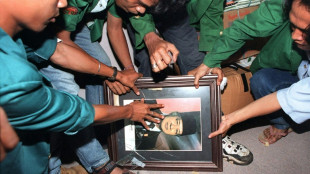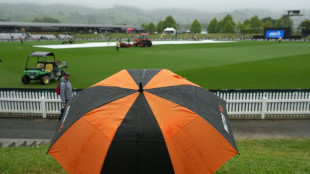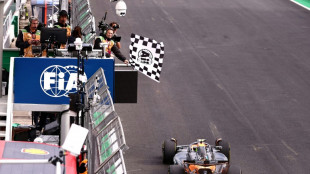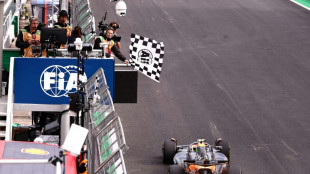-
 Japan death row inmate's sister still fighting, even after release
Japan death row inmate's sister still fighting, even after release
-
Taylor sparks Colts to Berlin win as Pats streak hits seven

-
 Dreyer, Pellegrino lift San Diego to 4-0 MLS Cup playoff win over Portland
Dreyer, Pellegrino lift San Diego to 4-0 MLS Cup playoff win over Portland
-
Indonesia names late dictator Suharto a national hero

-
 Fourth New Zealand-West Indies T20 washed out
Fourth New Zealand-West Indies T20 washed out
-
Tanzania Maasai fear VW 'greenwashing' carbon credit scheme

-
 Chinese businesswoman faces jail after huge UK crypto seizure
Chinese businesswoman faces jail after huge UK crypto seizure
-
Markets boosted by hopes for deal to end US shutdown

-
 Amazon poised to host toughest climate talks in years
Amazon poised to host toughest climate talks in years
-
Ex-jihadist Syrian president due at White House for landmark talks

-
 Saudi belly dancers break taboos behind closed doors
Saudi belly dancers break taboos behind closed doors
-
The AI revolution has a power problem

-
 Big lips and botox: In Trump's world, fashion and makeup get political
Big lips and botox: In Trump's world, fashion and makeup get political
-
NBA champion Thunder rally to down Grizzlies

-
 US senators reach deal that could end record shutdown
US senators reach deal that could end record shutdown
-
Weakening Typhoon Fung-wong exits Philippines after displacing 1.4 million

-
 Lenny Wilkens, Basketball Hall of Famer as player and coach, dies
Lenny Wilkens, Basketball Hall of Famer as player and coach, dies
-
Griffin wins PGA Mexico title for third victory of the year

-
 NFL makes successful return to Berlin, 35 years on
NFL makes successful return to Berlin, 35 years on
-
Lewandowski hat-trick helps Barca punish Real Madrid slip

-
 George warns England against being overawed by the All Blacks
George warns England against being overawed by the All Blacks
-
Lewandowski treble helps Barca beat Celta, cut gap on Real Madrid

-
 Neves late show sends PSG top of Ligue 1, Strasbourg down Lille
Neves late show sends PSG top of Ligue 1, Strasbourg down Lille
-
Inter go top of Serie A after Napoli slip-up

-
 Bezos's Blue Origin postpones rocket launch over weather
Bezos's Blue Origin postpones rocket launch over weather
-
Hamilton upbeat despite 'nightmare' at Ferrari

-
 Taylor sparks Colts to Berlin win, Pats win streak hits seven
Taylor sparks Colts to Berlin win, Pats win streak hits seven
-
Alcaraz and Zverev make winning starts at ATP Finals

-
 Protests suspend opening of Nigeria heritage museum
Protests suspend opening of Nigeria heritage museum
-
Undav brace sends Stuttgart fourth, Frankfurt win late in Bundesliga

-
 Roma capitalise on Napoli slip-up to claim Serie A lead
Roma capitalise on Napoli slip-up to claim Serie A lead
-
Liverpool up for the fight despite Man City masterclass, says Van Dijk

-
 Two MLB pitchers indicted on manipulating bets on pitches
Two MLB pitchers indicted on manipulating bets on pitches
-
Wales rugby captain Morgan set to be sidelined by shoulder injury

-
 After storming Sao Paulo podium, 'proud' Verstappen aims to keep fighting
After storming Sao Paulo podium, 'proud' Verstappen aims to keep fighting
-
US flights could 'slow to a trickle' as shutdown bites: transport secretary

-
 Celtic close on stumbling Scottish leaders Hearts
Celtic close on stumbling Scottish leaders Hearts
-
BBC chief resigns after row over Trump documentary

-
 Norris extends title lead in Sao Paulo, Verstappen third from pit-lane
Norris extends title lead in Sao Paulo, Verstappen third from pit-lane
-
Norris wins in Sao Paulo to extend title lead over Piastri

-
 Man City rout Liverpool to mark Guardiola milestone, Forest boost survival bid
Man City rout Liverpool to mark Guardiola milestone, Forest boost survival bid
-
Man City crush Liverpool to mark Guardiola's 1,000 match

-
 Emegha fires Strasbourg past Lille in Ligue 1
Emegha fires Strasbourg past Lille in Ligue 1
-
Howe takes blame for Newcastle's travel sickness

-
 Pumas maul Wales as Tandy's first game in charge ends in defeat
Pumas maul Wales as Tandy's first game in charge ends in defeat
-
'Predator: Badlands' conquers N. American box office

-
 Liga leaders Real Madrid drop points in Rayo draw
Liga leaders Real Madrid drop points in Rayo draw
-
'Killed on sight': Sudanese fleeing El-Fasher recall ethnic attacks

-
 Forest boost survival bid, Man City set for crucial Liverpool clash
Forest boost survival bid, Man City set for crucial Liverpool clash
-
US air travel could 'slow to a trickle' as shutdown bites: transport secretary

Russia's Drone ploy in Poland
Poland’s downing of multiple Russian drones that violated its airspace in the night of September 9–10 was not a random spillover from the war in Ukraine. The scale, timing and flight profiles point to a deliberate probe designed to test NATO’s vigilance, rules of engagement and political cohesion — a calibrated move that stayed just below the threshold for a mutual‑defense response while forcing the Alliance to reveal parts of its playbook.
A multi‑hour incursion, met with allied force
Over several hours, Polish and allied aircraft intercepted and shot down drone‑type objects crossing into Polish territory from the east. It was the first time in the current war that a NATO member engaged and destroyed Russian assets over allied soil. Authorities temporarily shut parts of Poland’s airspace and closed several airports; damage on the ground was limited — including a residential house struck in the Lublin region — and no casualties were reported. Officials recorded at least 19 incursions.
Why the operation looks planned — not accidental
1) Synchronization with mass strikes on Ukraine
The crossings coincided with a large, coordinated Russian wave against Ukraine involving hundreds of drones alongside cruise and ballistic missiles. Pairing a cross‑border incursion with a high‑tempo strike package is consistent with a playbook aimed at saturating sensors, overloading command centers and creating ambiguity about intent. In such windows, “strays” can be plausibly denied even as they gather intelligence and trigger costly responses.
2) Routes that matter
Preliminary trajectory analysis noted flight paths consistent with probing Poland’s critical logistics chain — above all the Rzeszów hub through which military aid flows to Ukraine. Even a small number of slow, inexpensive aircraft can force high‑end assets into the air, compel temporary airport closures and expose the Alliance’s alert timeline and coordination procedures.
3) Use of low‑cost and decoy‑like systems
Polish officials identified at least some of the intruding airframes as long‑range, low‑cost drones of a type Russia has used extensively. Such platforms are ideal for reconnaissance by provocation: they can map radar coverage, provoke emissions from air‑defense radars and fighters, and stress decision‑making — all with negligible risk to Russian aircrews and minimal political cost if shot down.
4) Cover from neighboring exercises and electronic warfare narratives
The incursion occurred as Russia and its ally Belarus prepared major exercises. That backdrop provides plausible deniability and alternative explanations (“lost course,” “jamming effects”) even as it positions assets near NATO borders and normalizes unusual air activity.
5) Testing NATO’s political seams
Warsaw publicly rejected suggestions that the drones might have wandered into Poland “by mistake,” framing the event as deliberate. Differences in early public messaging among allies are analytically notable: they are exactly the fissures that probing operations seek to widen — without triggering Article 5.
The allied answer — and what it signals
Poland activated NATO consultations and, within forty‑eight hours, the Alliance announced Operation Eastern Sentry, a flexible, integrated air‑and‑ground posture along the eastern flank. Additional fighters, surveillance platforms and air‑defense units from several member states are being positioned to rotate and adapt along the border arc — an approach designed to keep adversaries guessing while tightening reaction loops.
Domestically, Poland imposed drone bans and restrictions on small aircraft in its eastern airspace and moved to harden critical nodes. Border measures with Belarus were stepped up. Internationally, an emergency session of the U.N. Security Council was convened at Warsaw’s request. European capitals summoned Russian envoys and signaled further steps on sanctions and air‑defense cooperation. Ukraine, with two years of hard‑won counter‑drone expertise, offered to deepen technical training ties with Poland.
Strategic takeaways
- Probing as doctrine. Russia’s war has demonstrated a systematic reliance on massed, low‑cost drones to saturate defenses, expose gaps and harvest targeting and EW data. Exporting that method into NATO airspace — in controlled doses — is a logical extension.
- Ambiguity as a weapon. Unarmed or lightly modified drones crossing borders create maximum political friction for minimum military risk. They pressure alliances to choose between escalation and restraint, while providing Moscow with deniability narratives.
- Deterrence requires tempo. The Alliance’s swift shoot‑downs, rapid consultations and the launch of Eastern Sentry are meant to raise the cost of future probes, deny intelligence value and compress decision time. The next phase will be about integrating layered counter‑UAS systems, improving cross‑border command‑and‑control and hardening civilian aviation procedures along the frontier.
Bottom line:
The pattern — timing with mass strikes, purposeful routing toward critical hubs, employment of expendable platforms, and orchestration under the cover of concurrent exercises — supports the assessment that the drone violations over Poland were a planned strategic probe. The Alliance’s response will now determine whether such tests become rarer — or more audacious.

Electric car crisis: Future of a Audi plant?

Vladimir Putin, War criminal and Dictator of Russia

EU vs. Hungary: Lawsuit over ‘national sovereignty’ law

Ukraine: Zelenskyy appeals for international aid

Lebanon: Is a new wave of refugees coming to the EU?

Terrorist state Iran attacks Israel with missiles

Belarus: ICC investigates dictator Lukashenko

NATO: Ukraine ‘at the top of the list!’

NATO is training to fight cyber attacks

Digital Ocean Twin: Protecting the Oceans

What is the outlook for France’s economy?



